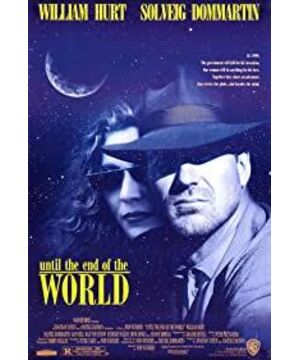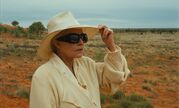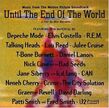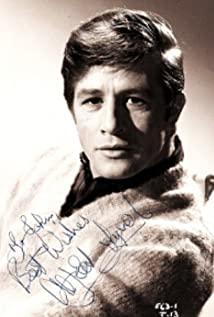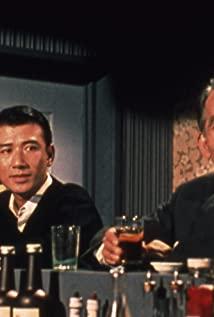The weather was getting hot day by day. In the movie, Claire chased Sam to the ends of the earth, water and fire, until the end of the world. I watched from a distance through the director's lens. What is this woman chasing?
I have always wondered, at the end of the world, can things come to an end? But I don't know - all the conditioned dharmas are like dream bubbles, dew and electricity, and should be viewed in this way. I'm not a Buddhist believer, but I think these four verses can't be used to describe the feeling this movie gives me.
It's actually a simple story. Virtually in 1999, the Indian nuclear satellite accident caused the world to panic because no one knew where the satellite would explode and what kind of damage it would cause. So everyone is in danger, the so-called end of the world.
Claire's ex-boyfriend cheated, she was sad and disappointed, wandering around, and by chance, she met bank robbers and helped them transport money. The money was "borrowed" by Sam without notice. Claire started chasing after him. He started chasing after money, but then he fell in love with him. He paid the money, and the person who chased him had to protect him from being caught by others. The ex-boyfriend came to chase after Claire, a private detective was hired to help Claire chase Sam, a public detective chased Sam who had industrial secrets, a bank robber started chasing Claire and then turned to help her. The whole movie is in such a complicated chasing and being chased. , struggling to escape, between the interests of each other, hula suddenly turned into a science fiction movie -
sam's secret, stealing money, stealing things, running around, all for his mother, to help his father's great scientific experiment, let the blind mother Goodbye Guangming, let my mother see the smiling faces of relatives and friends scattered all over the world. So France, Portugal, Beijing, Tokyo, Siberia, Moscow, San Francisco, everywhere.
Claire loves him, it's just absurd. He didn't treat her any favors, but that woman was like a cow.
Chased to the end of the world, where the Australian Aboriginal people are, the mountains are like a maze. It is also willing to sacrifice himself as an experimental white mouse. The man showed his ugly side step by step without realizing it.
The experiment was successful, but the mother died. The nuclear satellite exploded, and no one knew if anyone else was alive in the rest of the world.
Their experiments began to turn into people's dreams.
The natives refused to take part in this horrific experiment and left. The only three people were caught in their own nightmares, unable to extricate themselves.
The principle of capturing and transferring the visual signals of the brain into images on the screen is as simple as that. But how can people's dreams be shown to people? To use a vulgar analogy, they opened Pandora's box. Everyone doesn't care about anything except their own dreams. Every day, hold on to the dream machine, hide yourself in a small dark place, and keep looking. Then love yourself so much and feel sorry for yourself. It was more alive and real than the mirror, and they all became Narcissus, or worse. In her dream, Claire saw her childhood, and she felt how healthy and happy she was at that time. It is also a little strange that they always see themselves repeatedly in their dreams, whether they are frightened, sad, or happy. But I hardly ever have. Maybe I can't remember it myself? I have no way of knowing...
their spirits are almost broken, claire's ex-boyfriend saved her with words, sam's aboriginal friends helped him with their own methods, and sam's father was finally captured by the Americans..
.and then everyone wakes up from their dreams .
The man I disliked the most at the beginning turned out to be Claire's savior. This incident first broke my eye, and then I thought that the movie was originally based on this man's novel as a narrative angle. It's okay to write as high and complete as you like, saving a woman counts as nothing. Just relieved. Besides, they weren't together.
This movie looks like a love movie at the beginning, but it ends very pessimistically. When I catch it, I realize that it is completely worthless. But to warn women not to chase bubble-like love? Does Claire regret her long trip? Maybe not. Everything is a dream bubble Ye Hao, as well as the beauty of the scenery along the way.
In the part of Beijing, when looking out from the hotel, you can see a huge hairy statue with the characters "Freedom" on both sides. Laugh secretly. Wenders probably wouldn't understand that in China, writing about development, taking off, writing about democracy, about having fewer children and raising pigs, and about freedom is a must. At least I haven't seen it yet. Liberalization, liberalism, are not good words... The Chinese man taught her Chinese, chopsticks, and napkins. Old man riding a bike on a country road. These details are real. The film highlights the characteristics of China, it seems that only red, backward, plus the people are still simple. Compared with the Japanese part, the old Japanese used herbal medicine to treat Sam's eyes, and the quiet beauty of the Japanese mountain forest house made him feel a little hostile in his heart. In terms of the breadth and depth of culture, we are definitely not inferior to Japan. Chinese herbal medicine is also our thing. Why is it like this in the impression of foreign directors? It would be too far away to get entangled in the topic, anyway, everyone knows.
This movie is like a road movie. People are always on the road, or about to be on the road.
When watching this movie, at a certain scene, I feel familiar, very similar to Wenders' photography, I have seen it more than once. That part of Australia, the road in the photo, is a kangaroo squashed by a van.
Movies give a lot of images to landscapes other than people. Like Wenders says in the book -
I'm a firm believer in the power of storytelling
in landscapes . There are some landscapes, whether cities, deserts, mountains or coasts, that express a story urgently. They can create their own stories. The scenery itself can be the protagonist, and the people who haunt it are just playing tricks. Maybe so. This explains most things. But I still like Solveig, the woman who was loved by an angel under the Berlin sky, who is more mundane here like a real person. Polar Bear 05 05 31
View more about Until the End of the World reviews


